
Catocala fulminea, the yellow bands underwing, is a moth of the family Erebidae. The species was first described by Giovanni Antonio Scopoli in his 1763 Entomologia Carniolica. It is found in central and southern Europe, east Asia and Siberia. The xarippe lineage has been proposed to be a distinct and valid species in its own right, instead of being only subspecifically distinct.
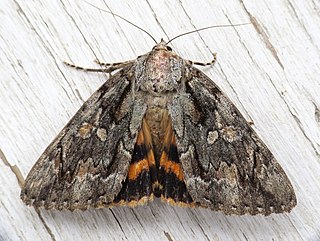
Catocala neogama, the bride, is a moth in the family Erebidae first described by James Edward Smith in 1797. It is found in North America east of the Rocky Mountains, from Maine and Quebec south to northern Florida and west to South Dakota, New Mexico, and into Arizona and Texas. Its westernmost population from the semiarid Colorado Plateau region is rather distinct and was once considered a separate species, but is now regarded as a well-marked subspecies C. n. euphemia.

Catocala meskei, or Meske's underwing, is a moth of the family Erebidae. The species was first described by Augustus Radcliffe Grote in 1873. It is found in North America from Maine and Quebec west to southern Alberta and Montana, south to South Carolina in the east and at least Montana in the west.

Catocala junctura, the joined underwing or Stretch's underwing, is a moth in the family Erebidae. The species was first described by Francis Walker in 1858. It is found throughout temperate North America, ranging from New York and Pennsylvania west to Montana, Colorado, Oklahoma, Arizona, and into Texas, and north to southern Illinois, extreme southern Alberta and Saskatchewan; it has also been recorded west of the Rocky Mountains from California and south-eastern British Columbia. It is typically found near water, where the food plants of its caterpillar larvae grow plentifully.
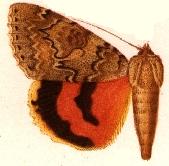
Catocala luciana, the shining underwing, is a moth of the family Erebidae. The species was first described by Herman Strecker in 1874. It is found in western North America, as far east as Minnesota and Illinois and northward into extreme southern Alberta and Saskatchewan. It occurs widely across the Great Plains, south to New Mexico, Arizona and California.
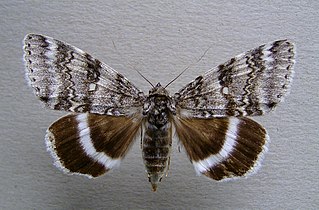
Catocala relicta, the white underwing or relict, is a moth of the family Erebidae. The species was first described by Francis Walker in 1858. It lives in southern Canada, from Newfoundland to Vancouver Island, south to Missouri, and Arizona.
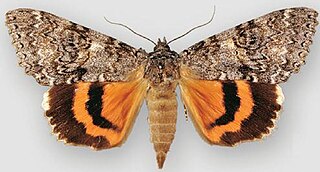
Catocala unijuga, the once-married underwing, is a moth of the family Erebidae. The species was first described by Francis Walker in 1858. It is found in North America from Newfoundland west to south central British Columbia, south to Kentucky and Missouri in the east, Colorado and Utah in the west.

Catocala conversa is a moth of the family Erebidae first described by Eugenius Johann Christoph Esper in 1787. It is found in the Mediterranean zone and parts of the sub-Mediterranean zone.
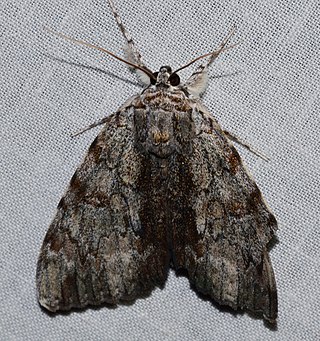
Catocala insolabilis, the inconsolable underwing, is a moth of the family Erebidae. The species was first described by Achille Guenée in 1852. It is found in North America from Ontario through Maine and Connecticut south to Florida, west through Arkansas to Texas and Oklahoma and north to South Dakota.

Catocala innubens, the betrothed underwing, is a moth of the family Erebidae. The species was first described by Achille Guenée in 1852. It is found in North America from southern Ontario and Quebec south through Michigan, Connecticut, Tennessee to Florida and west to Texas and Oklahoma and north to Wisconsin.

Catocala muliercula, the little wife underwing, is a moth of the family Erebidae. The species was first described by Achille Guenée in 1852. It is found in the US from Massachusetts and Connecticut south to Florida and west to Texas and New Mexico.

Catocala palaeogama, the old wife underwing, is a moth of the family Erebidae. The species was first described by Achille Guenée in 1852. It is found in North America from Ontario and Quebec, through Maine, New Jersey, Tennessee, to South Carolina, west to Arkansas and Oklahoma and north through Iowa, Indiana, Illinois and Michigan.

Catocala delilah, the Delilah underwing, is a moth in the family Erebidae. The species was first described by Strecker in 1874. It is found in the southern and midwestern United States, from Ohio south to Florida and west to Texas and Oklahoma.

Catocala desdemona, the Desdemona underwing, is a moth of the family Erebidae. The species was first described by Henry Edwards in 1882. It is found in Utah and Arizona, ranging south into New Mexico and Texas, and onwards through Mexico up to Honduras.
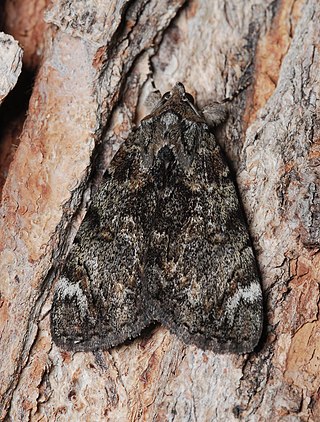
Catocala minuta, the little underwing, is a moth of the family Erebidae. The species was first described by William Henry Edwards in 1864. It is found in the US from New York to Florida and west to Texas and north to South Dakota, Indiana and Michigan.
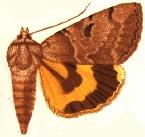
Catocala nuptialis, the married underwing, is a moth of the family Erebidae. The species was first described by Francis Walker in 1858. It is found in North America from Manitoba south through Minnesota and Nebraska to eastern Oklahoma and Texas and east to Kentucky and Illinois.
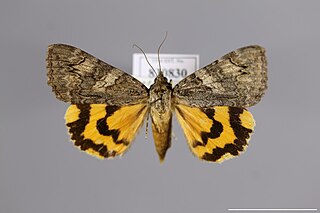
Catocala helena is a moth of the family Erebidae. It is found in Siberia and Manchuria.

Catocala orba, the Orba underwing, is a moth of the family Erebidae. The species was first described by Nikolai Yakovlevich Kuznetsov in 1903. It is found from Massachusetts south to Georgia and Florida, west to Texas, and as far north as Mississippi.

The Erebinae are a subfamily of moths in the family Erebidae erected by William Elford Leach in 1815. Erebine moths are found on all continents except Antarctica, but reach their greatest diversity in the tropics. While the exact number of species belonging to the Erebinae is not known, the subfamily is estimated to include around 10,000 species. Some well-known Erebinae include underwing moths (Catocala) and witch moths (Thermesiini). Many of the species in the subfamily have medium to large wingspans, up to nearly 30 cm in the white witch moth, which has the widest wingspan of all Lepidoptera. Erebine caterpillars feed on a broad range of plants; many species feed on grasses and legumes, and a few are pests of castor bean, sugarcane, rice, as well as pistachios and blackberries.
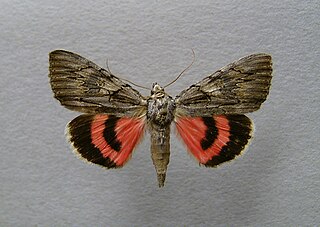
Catocala optata is a moth of the family Erebidae first described by Jean-Baptiste Godart in 1824. It is known from south-central Europe and north-western Africa.
















